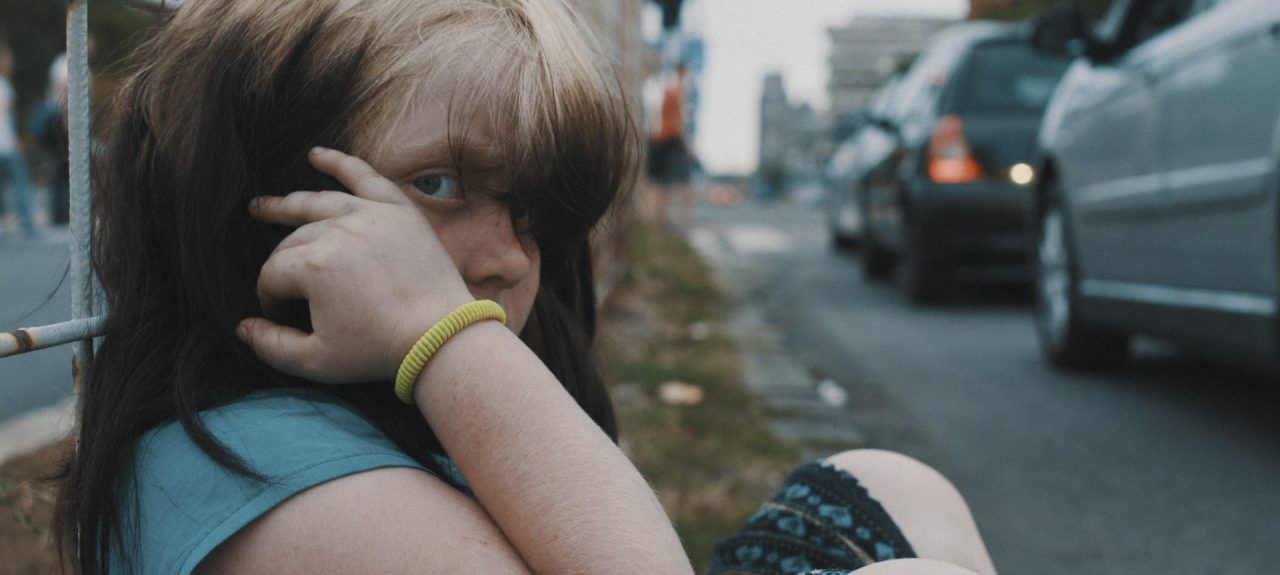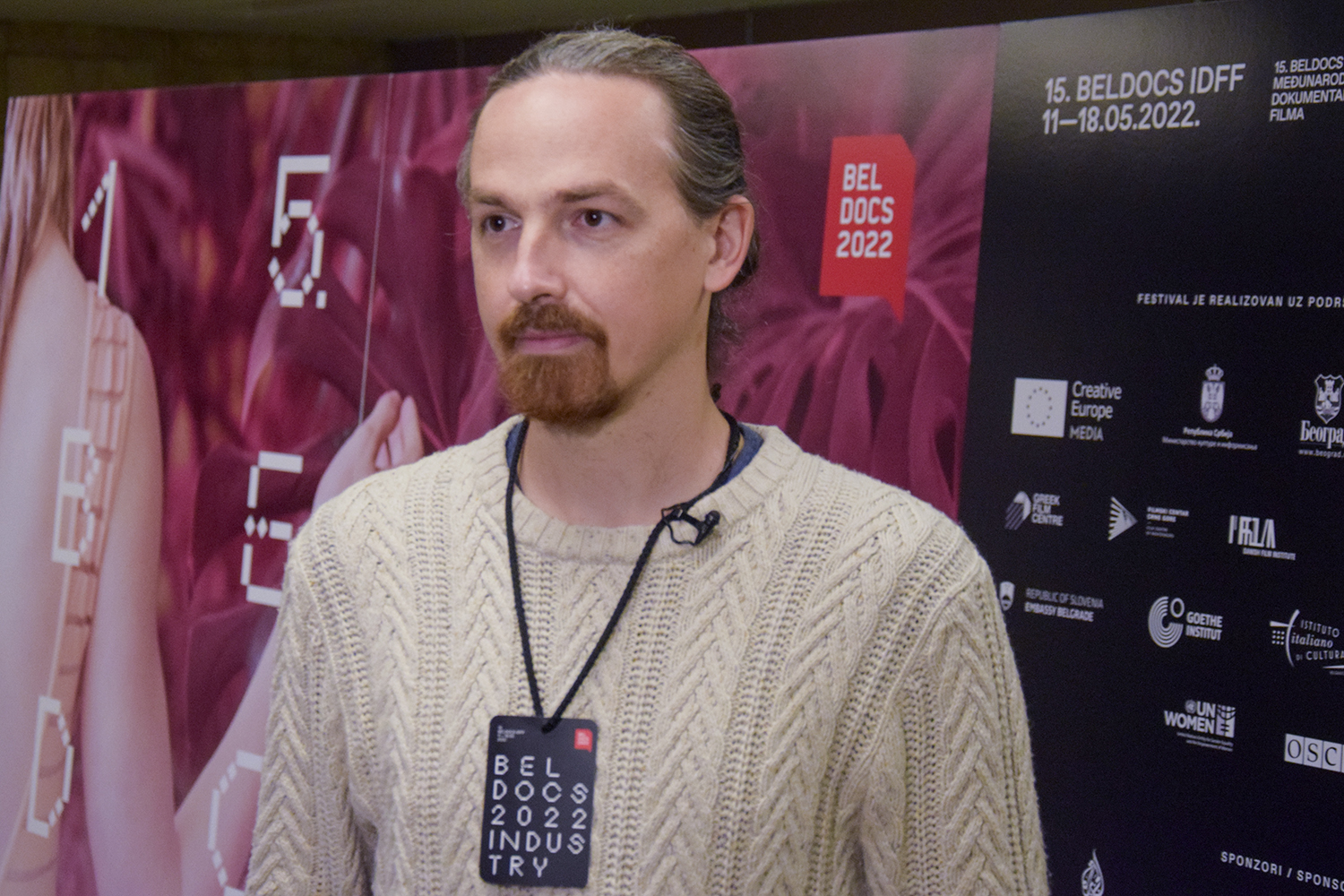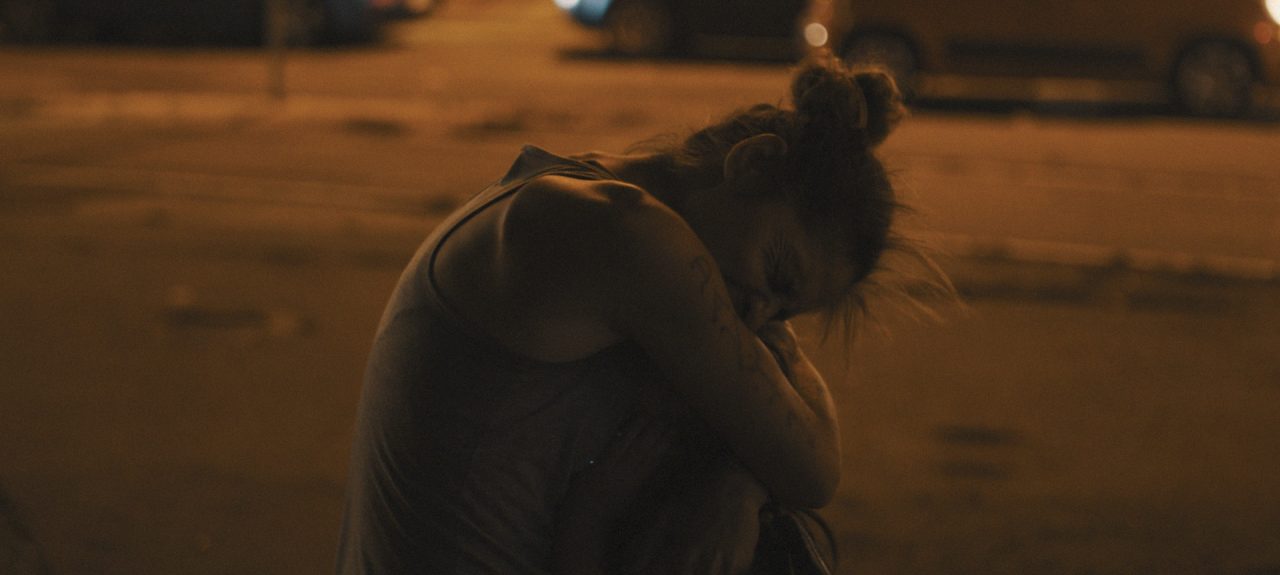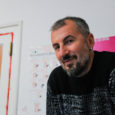Srđan Keča’s cinematographic journey, at least in the eyes of the general audience, started the moment he decided to face the fact that his father was a volunteer soldier during the 1991 war in Croatia at the battlefield of Vukovar. Keča confronted this fact during the shooting of his film “A Letter to Dad,” in which he explores how the war had changed his family.
This personal story turned into a film about an entire generation whose parents were soldiers in the countries created in the dissolution of Yugoslavia. Keča carved out a space for all of them to ask their parents about what they were doing during the war.
After “A Letter to Dad,” which was shown around the world and won multiple awards, Keča continued to grapple with difficult topics, constantly examining the world around him. The film “Mirage” came next, a story about the workers who carry the burden of building Dubai, and then “Bijeg” (The Escape), a movie centered on Roma women in Bosnia and Herzegovina. Then came “Flotel Europe,” a story about Bosnian refugees in Denmark.
This year, Keča will again be making the rounds at film festivals showing his first feature-length documentary, “Muzej revolucije” (Museum of the Revolution), a story about an incomplete museum building in Belgrade. Construction on the building began in the 1950s between what was then the Federal Executive Council (today’s Palace of Serbia) and the building of the Central Committee of the League of Communists (where today’s Ušće shopping mall stands). Decades later, only the foundations remain and hardly anyone remembers the museum.
But these foundations have often been a refuge for people with no home. Keča follows three generations of women who lived there: Mara, who resided there with her partner for years, and Vera and Milica, a mother and daughter who came after Belgrade authorities displaced Roma from where Belgrade Waterfront — a massive luxury residential complex — was being built.
Parallel with their personal stories, Keča’s focus on the building turns it into a metaphor about a country, a system and a people about which we know little. Preserving these stories, the film becomes a museum.
Keča, who has received awards for his documentaries from festivals in Berlin, Madrid, London and Prizren’s DokuFest, spoke with Kosovo 2.0 over video call about the creation of Museum of the Revolution and about the people living around us who go unnoticed.

A building was never built on the foundations of the Museum of the Revolution Museum, but the place has become a refuge for many without a home. Photo: Courtesy of Vanja Jambrović and Restart production.
K2.0: The film is a story about three generations of women. Their relationships, love and attention they pay to each other seem to be some kind of revolution in the world of the alienated. Still, the movie’s title could easily lead people to believe that the story focuses on Belgrade’s Museum of the Revolution. What was your guiding idea?
Srđan Keča: People often ask, especially in our region, why the title is “Museum of the Revolution” if the story talks about those three heroines. We are all trained to expect that stories on socialist heritage and the overall ruins in our region will have a certain shape and form. But there are films about the ideas of Vjenceslav Richter [the Museum’s architect], which aligned more closely with the ways of thinking derived from the socialist heritage. The focus is on the architecture and the people play a secondary role. The focus is on the history of what this space was supposed to become.
During many years of acquaintanceship with the people who lived in that basement, the history of that space in the last few decades, for how long people were living there, has become at least as significant as the space itself.
Most Belgraders don’t know that there is anything in this space between these two former buildings from the former state. They don’t know that there is some incomplete building, and even less that this building was supposed to be the Museum of the Revolution. How was this history erased from our memory?
If we consider which histories were erased, it was what the space was supposed to be, that history, that was erased. Most Belgraders, even if they know that something used to exist there, they don’t know what it is.
People are writing about this place as the location where the Belgrade Philharmonic will be built, but no article mentions what we can find there today, let alone information about the ideas behind the Museum of the Revolution Museum, which were radical for that period of socialism. That history was erased. Also, the history of the people who lived there, in that space, for decades will be erased. No one gets in touch with them, most people don’t even live there anymore, and those who stayed will be removed. In the end, the movie will stand as a testimonial to the lives that existed there.

Srđan Keča’s films question the past, the consequences of wars and the dissolution of a country. Photo credit: Vanja Jambrović and Restart Production.
In time, their stories attained exceptional value in my eyes. What drew me back to that space was no longer the history of the space and what it ought to become, but the history of what happened to those people who lived there and their stories about mutual care, about one cruel tenderness which I found among those people, which I tried to accentuate in this movie.
In the end you kept the original framework and title. Why?
It is like some sort of mirror in which other elements of the movie are reflected — relations between the heroines, their relationship with unseen heroes, that is, the men in their lives, gentrification — which is obvious in the movie, the enormous transformation of Belgrade and modern construction but also [other types of construction] that can be seen at the beginning of the movie, from the days of the construction of New Belgrade.
And then the title remained as a metaphor, as key for thought, not as a space but as something that remains to be interpreted — what does the phrase Museum of the Revolution mean and what is the museum, what is the revolution, and when we join the two together, what do we get?
The whole story can be seen as some sort of revolution in considering people’s relationships, because it’s a rare sight in today’s world to see so much warmth and care for each other. Was that your intention?
This is what brought me back to that space, those stories about mutual care. When we first went there in 2014, with Radiša Cvetković, the assistant director and boom operator who worked with me, Mara was the first person I met, and back then she was together with her late husband, Zoran. They told us stories about caring for each other and then about the care other people provided to them, and all this brought us back to that space. When Mara’s partner died, it was then that I realized that I owed it to myself and to them to make another movie.
How did they respond to your arrival and to the filming?
There was a natural flow of events. We visited the space often. In 2014, 2015, 2016, we went there with our camera. In most cases, we didn’t shoot anything but just spent time with them, mostly with Mara.
It started from that space, from my interest in that space, and then somehow it all moved around. We started shooting in January 2017 — when I saw that Mara was playing with Milica, who was young back then. In this relationship I found the kernel from which to start working on the movie, and the next morning we started shooting what I thought would be the movie material. And then got lost a bit. We followed their life events and tried to see how they fit with the movie’s structure, which could focus on the city or society, and not only on the three of them.
Vera and Milica are Roma. I believe that most people who lived there were Roma. Systems have changed, but the attitudes toward Roma haven’t changed much, especially toward Roma women, who remain on the margins. How do the movie’s heroines grapple with this issue?
This relationship underwent a sort of evolution. It has been getting worse since the 1950s, worse and worse. Today, as we all know, they have been pushed to the side in the sense that society doesn’t want them to be visible at all. And then comes the philosophy of displacement… Vera didn’t know where to go with her child. For the people who were displaced, containers were secured in Belgrade’s periphery where they were not welcomed, where no economy existed in which they could take part, particularly Roma women who can’t participate in the conventional economy almost in any way. This is what the movie tries to portray.

The Museum of the Revolution is a story about the destinies of forgotten people. Photo: Courtesy of Vanja Jambrović and Restart production.
We placed them in the center of the movie but it is clear that they are somehow invisible in today’s society. It’s interesting those little interactions between those people in cars whose windshields they wipe. The exchange of money happens there with a great deal of distance and suspicion on both sides, and they don’t participate in the world in any other way. When we portray the scene with the concert happening on the foundations of the Museum of the Revolution, they don’t show up in any of the scenes that focus on the city, which we used to suggest that they aren’t part of that world.
At one point, Vera and Milica are sitting next to the Sava River, near the Staro Sajmište, where there was a concentration camp during World War Two where, along with Jews, a large number of Roma were brought. And there is something symbolic about that because that space was barely marked in any way, while people rarely mention the suffering of Roma that happened at Staro Sajmište. How should we think about this part of history?
Strolling along at some point we passed there and I wanted to touch upon that history. In the editing phase, we had to make some decisions and focus on the personal story more than on the broader history of Belgrade. They were even living there at one point.
But the suffering of the Roma isn’t part of the collective consciousness of people in Serbia. Just like in recent history when the suffering and expulsion of Roma from Kosovo wasn’t covered much — how it influenced the Roma community across the Balkans. This great exodus and displacement, it is still not part of people’s collective consciousness in Serbia.
Still, this movie isn’t just another story about Roma, the type that has been done several times before. What was it that you tried to do during the shoot, and what makes your approach different?
I wanted to show their lives in a way that it’s as if we’re not talking about Roma. It’s interesting how much it’s become a norm in our region, when a movie about Roma is being made, to create this documentary film subgenre where Roma always play their role from a distance, which is done by focusing on aspects of culture and tradition. It’s always the music, this explosive energy, and in almost 100% of cases, the focus is on the men. I wanted to push that to the side and concentrate on the material aspects of their lives, not the cultural ones, the traditions, but on the material, on money, on the husband who is in jail and receives money from them. I wanted to push everything else to the side.
My experience from my previous movie, which I also did with three generations of Roma women from near Tuzla, was that when I would focus on the women in that community, their experience was significantly different from what the media and the films portray about these Roma stories. I wanted to invert this and try to film them in a way that would also include members of their families.
How much did your relationship with them bring you all together? That is, how much did you get personally and emotionally invested in the story? How did you deal with the desire to help them in some way?
This is the hardest question. This was definitely the most difficult part of making this movie because, when a person spends as much time with the heroines of the film as we did, you can’t do nothing. It would be deeply immoral.
We were dealing with this from the beginning of our work. Even though we were just filming the space, we were in their home. That was clear to me from the start, and it’s what I said on the first day, and it’s what established good relations between us, that they would not have any benefits from our presence, but if some benefits were to materialize, they would not come as a result of the film. But it’s impossible to spend so much time with people, with the movie’s heroines, and for a person to do nothing. At the same time, it is problematic to influence their lives in a way that would change the course of the movie or change the story of their lives.
It was terribly difficult to strike a balance, but we tried and today we are still trying to help as much as we can. I’m the first to admit that it’s horribly difficult and in 90% of cases, everything we wanted or would like to happen didn’t turn out. Things most often ended in a half-success or a failure because it is a difficult task, they were things that the state should do. Only the state that has the power and the resources to deal with it all, but it’s not doing what it should.
There is this attitude that these communities have unwritten rules and that individuals aren’t treated as such but only as part of the community. We will provide them with containers or we won’t do anything, and let them figure things out. There’s no deep engagement with the community’s problems.
We tried to be of use especially to the children. We thought that we could affect things the most there, and it’s there that we perhaps accomplished something. I think we don’t have permission to talk about how they currently live and what is happening with them because the people who agreed to participate in the movie accepted that certain parts of their lives would be exposed to the public, but they didn’t give us permission to go further.
Did the main heroines watch the movie?
We showed them plenty of material. Milica liked looking at the material. For most of the time, we sat with them, and especially with her, and we were not filming but talking and learning from her, as she did from us. She was constantly checking the material and had a super filter. She understood very well what the movie aimed to achieve, everything was clear to her because she is an incredibly intelligent person.
Whenever she found something unpleasant or felt that it didn’t belong in the movie, she would just turn toward the camera, make a cut with her fingers, and thus stop the shooting. She understood that very well.
In the community, reactions to the movies vary. Whenever people see themselves on the screen, they don’t interpret it the same way as the public. They don’t see in the movie that which I wanted to show to the audience.
Will you continue working on this relationship between the past and its influence on the present?
Some things I already managed to get out of my system, those things that could be found in the previous movies and even in this one. That’s how, in a rather intensive period, we had “A Letter to Dad,” and then “Mirage,” which was recorded in Dubai… This movie is the unification of those interests because Dubai came to Belgrade in the meantime — in some pretty obvious ways.
After this, I’m interested in topics that are geographically wider than our region. But at the same time, I can’t get away from the topics that defined the first 20 or so years of my life.
Feature image: Courtesy of Vanja Jambrović and Restart production.
The content of this article is the sole responsibility of K2.0. The views expressed in it are the author’s and do not necessarily reflect the views of K2.0.
Curious about how our journalism is funded? Learn more here.




